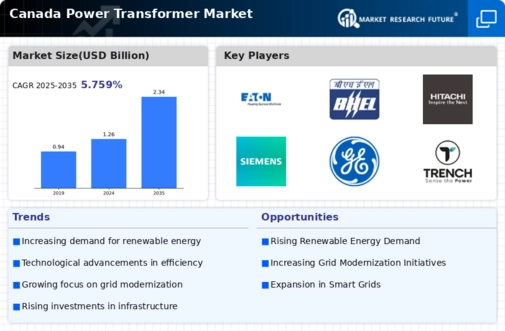Aging Infrastructure and Upgrades
Canada's aging electrical infrastructure presents a significant driver for the power transformer market. Many existing transformers are nearing the end of their operational lifespan, leading to increased maintenance costs and reliability issues. The government has recognized the need for modernization, with an estimated investment of $10 billion allocated for infrastructure upgrades over the next five years. This investment is likely to spur demand for new power transformers that meet contemporary efficiency and safety standards. The power transformer market is thus positioned to benefit from this trend, as utilities seek to replace outdated equipment with advanced technologies that enhance grid resilience and performance.
Regulatory Framework and Standards
The regulatory environment in Canada is evolving, with stricter standards for energy efficiency and emissions. The government is implementing policies that require utilities to upgrade their equipment to comply with these regulations. This shift is expected to drive the power transformer market, as utilities will need to invest in transformers that meet new efficiency benchmarks. For instance, the Canadian Standards Association has introduced guidelines that mandate a minimum efficiency level for transformers, which could lead to a market growth of approximately 15% in the coming years. The power transformer market must stay abreast of these regulatory changes to ensure compliance and capitalize on the opportunities they present.
Growing Demand for Renewable Energy
The increasing emphasis on renewable energy sources in Canada is driving the power transformer market. As the country aims to reduce its carbon footprint, investments in wind, solar, and hydroelectric power are surging. This shift necessitates the deployment of advanced power transformers to manage the integration of these variable energy sources into the grid. In 2025, the renewable energy sector is projected to account for approximately 30% of Canada's total energy generation, thereby creating a substantial demand for efficient and reliable power transformers. The power transformer market must adapt to these changes by developing transformers that can handle the unique challenges posed by renewable energy, such as fluctuating loads and grid stability.
Technological Innovations in Transformer Design
Innovations in transformer technology are significantly influencing the power transformer market. The development of smart transformers, which incorporate digital monitoring and control capabilities, is becoming increasingly prevalent. These advanced transformers can optimize energy distribution and enhance grid management, aligning with the growing trend towards smart grid solutions. In Canada, the adoption of smart grid technologies is expected to increase by 20% by 2027, thereby boosting the demand for smart transformers. The power transformer market is likely to see a shift towards these innovative solutions, as utilities seek to improve operational efficiency and reliability.
Increased Investment in Electric Vehicle Infrastructure
The rise of electric vehicles (EVs) in Canada is creating new opportunities for the power transformer market. As the government promotes EV adoption through incentives and infrastructure development, the demand for charging stations is expected to grow. This, in turn, necessitates the installation of robust power transformers to support the increased load on the electrical grid. By 2025, it is anticipated that the number of EV charging stations will triple, leading to a corresponding increase in transformer requirements. The power transformer market must respond to this trend by providing transformers that can handle the unique demands of EV charging, ensuring grid stability and reliability.

















Leave a Comment